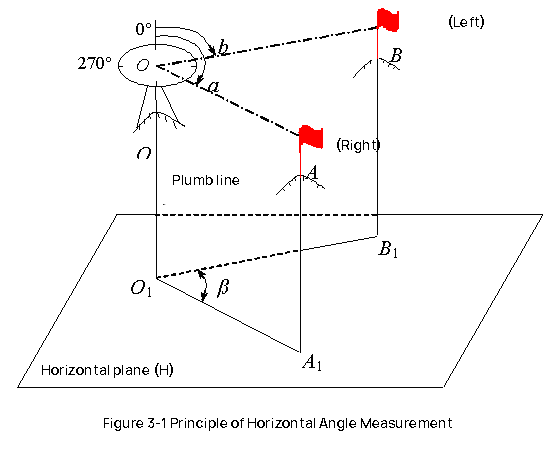Section 1: Principle of Horizontal Angle Measurement
I. Concept of horizontal angle
The angle formed by perpendicular projection on a horizontal plane of two directional lines intersecting at a point is known as horizontal angle. It is usually represented by β, with an angle range of 0˚ to 360˚.
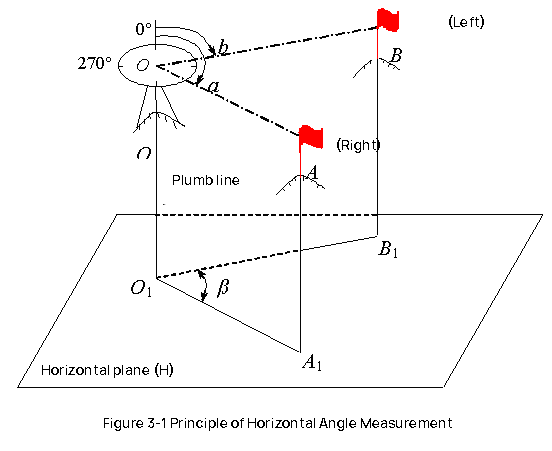
As shown in Figure 3-1, A, O, and B are arbitrary points on the ground. The horizontal angle between the directional lines OA and OB is the angle formed by the perpendicular projections O1A1 and O1B1 of OA and OB on the horizontal plane H. This angle is represented by β.
II. Principle of horizontal angle measurement
As shown in Figure 3-1, a graduated circle is placed horizontally at any height above point O. The center of the circle coincides with the plumb line passing through point O. Two vertical planes are established through OA and OB respectively, and the readings intersected by these two vertical planes on the graduated circle are denoted as a and b. The value of the horizontal angle β can be calculated as follows:

Instruments used to measure horizontal angles must have a level disc that can be placed in a horizontal position, and the center of the level disc must coincide with the plumb line passing through the apex of the horizontal angle.
The instrument's telescope not only rotates in the horizontal plane, but also in the vertical plane. The theodolite is designed and manufactured in accordance with the above basic requirements for angle measurement.
Section 2: Optical Theodolite Structure
Optical theodolites are classified into different levels based on their measurement accuracy, such as DJ 07 DJ 1 DJ 2 DJ 6 and DJ 15 . “DJ” represents the first letter of the Chinese pinyin for “geodetic survey” and “theodolite,” respectively, while the subscripts 07, 1, 2, 6, and 15 indicate the instrument's level of accuracy, which is expressed as “the standard deviation from direction observation error to a measurement in seconds.”
I. Structure of the DJ 6 Optical Theodolite
The DJ 6 optical theodolite mainly consists of three parts: the aiming system, the level disc and the base.
1. Aiming system
The aiming system refers to the part above the level disc that can rotate around its axis. The aiming system is mainly composed of a vertical axis, telescope, vertical disc, reading device, leveling tube and optical collimator.
(1) Vertical Axis: The rotation axis of the aiming system is called the vertical axis of the instrument. By adjusting the locking screw and fine adjustment screw, the rotation of the sighting system in the horizontal direction can be controlled.
(2) Telescope: The telescope is used to aim at the target. Furthermore, to facilitate accurate targeting, the crosshairs of the theodolite's reticular plate are slightly different from those of the level. See Figure 3-3 for details.
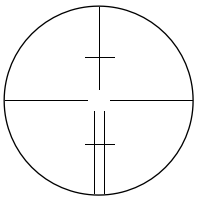
The axis of rotation of the telescope is called the horizontal axis. By adjusting the locking screw and fine adjustment screw of the telescope, its up and down rotation can be controlled.
The telescope's line of sight is perpendicular to the horizontal axis and the horizontal axis is perpendicular to the vertical axis of the instrument. Therefore, when the vertical axis of the instrument is vertical, the telescope rotates around the horizontal axis to scan a vertical plane.
(3) Vertical Disk: The vertical disk is used to measure vertical angles and is fixed at one end of the horizontal axis and rotates with the telescope.
(4) Reading device: The reading device is used to read the readings of the level disc and the vertical disc.
(5) Leveling tube: The leveling tube of the aiming system is used to level the instrument accurately. The axis of the leveling tube is perpendicular to the vertical axis of the instrument. When the bubble of the leveling tube is centered, the vertical axis of the theodolite is vertical and the leveling disc is in a horizontal position.
(6) Optical Collimator: The optical collimator is used to make the center of the level disk coincide with the plumb line passing through the station point.
2. Level disc
The level disc is used to measure horizontal angles. It is a circular ring made of optical glass with graduations from 0° to 360° marked. Full degree graduations are labeled with annotations and the graduation values are 1° or 30′, labeled clockwise.
The level disk is separate from the targeting system and does not rotate with the targeting system when it is moved. If it is necessary to change the position of the level disc, the level disc change wheel on the sighting system can be used to move the disc to the desired position.
3. Base
The base serves to support the entire instrument and fix the theodolite to the tripod using a central connection screw. There are three foot screws on the base to level the instrument. Additionally, there is a set screw socket on the base used to control the connection between the aiming system and the base.
II. Device and reading methods
When the reading on the level disk is less than the graduation value, a micrometer is used to take the reading. The DJ 6 optical theodolite usually uses a vernier micrometer.
As shown in Figure 3-4, there are two reading windows visible through the reading microscope: the window with “Horizontal” or “H” is for reading the level disk, and the window with “Vertical” or “V” It is for reading the vertical disc. Each reading window has a vernier scale.
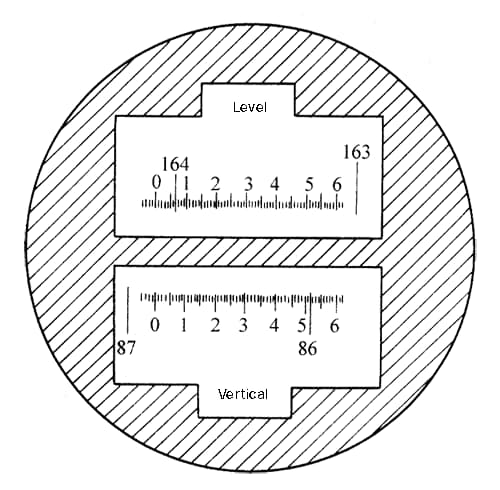
The length of the vernier scale is equal to the width of the 1° image on the level disk. The entire length of the vernier scale represents 1°. The vernier scale is divided into 60 small divisions, with each small division representing 1′, which can be estimated as 0.1′ or 6″. Every 10 small divisions are marked with a number indicating multiples of 10′.
To take a reading, first adjust the eyepiece of the reading microscope to focus on the graduation line in the reading window and make sure it is clear.
Next, read the degree value indicated by the graduation line on the vernier scale, and finally, read the fractional part less than 1° on the vernier scale using the graduation line as a reference while estimating the number of seconds.
As shown in Figure 3-4, the reading on the level disk is 164°06′36″ and the reading on the vertical disk is 86°51′36″.
III. Introduction to the Structure of DJ 2 Optical Theodolite
1. Features of DJ2 Optical Theodolite
Compared with DJ6 optical theodolite, DJ2 optical theodolite has the following features:
(1) The structure between the axes is stable, the magnification of the telescope is greater, and the sensitivity of the leveling tube in the aiming system is greater.
(2) In the DJ2 optical theodolite reading microscope, only an image of the level disk or the vertical disk can be seen. When reading, the disc image that needs to be read is displayed by turning the image conversion wheel.
(3) The DJ2 optical theodolite uses a counter-parallel reading device, which is equivalent to obtaining the average value of two readings separated by 180° on the disk, thus eliminating the influence of eccentricity errors and improving the reading accuracy.
2. DJ2 optical theodolite reading method
The contraparalletic reading device reflects the graduations on the disk relative to the line 180° away from them simultaneously into the reading microscope through a series of prisms and lenses, and they appear in a horizontal line above and below the midpoint, as shown in Figure 3-6.
The window in the lower right corner shows the coincidence of the graduation lines. The number above the reading window in the upper right is the degree value, the number in the small raised box in the center is the multiple of 10′, and the reading window in the lower left is for the micrometer.
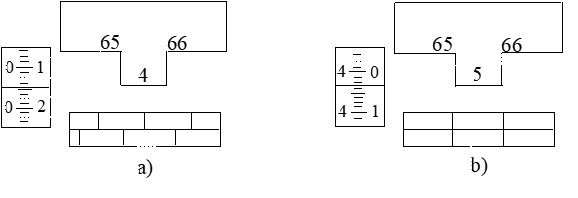
The micrometer scale is divided into 600 small divisions, with each division representing 1″. The micrometer scale range is 10′ and can be estimated to be 0.1″. The number on the left side of the micrometer reading window is the minute value, and the number on the right side is the multiple of 10″. The reading method is as follows:
(1) Rotate the micrometer wheel to make the graduation lines in the coincidence window coincide precisely, as shown in Figure 3-6b.
(2) Read the degree value in the reading window.
(3) Read the multiple of 10′ in the small protruding box in the center.
(4) Based on the position of the single index line in the micrometer reading window, directly read the fractional part less than 10′ and the seconds estimating 0.1″.
(5) Add the degree value, the multiple of 10′ and the micrometer scale reading to obtain the disc reading. The reading in Figure 3-6b is:
65°+5×10′+4′08.2″=65°54′08.2″.

